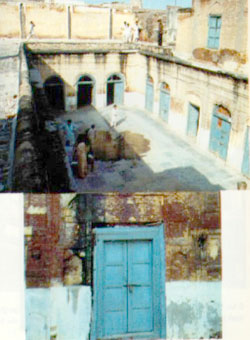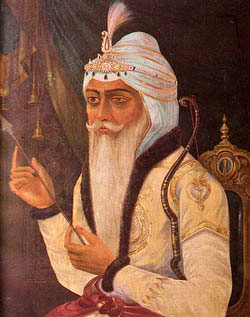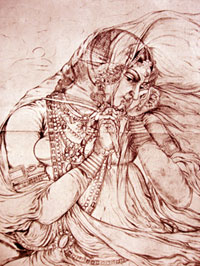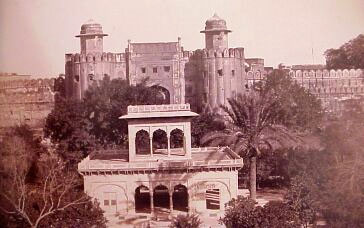Ancestory and Childhood
Ranjit Singh was born on Nov. 13, 1780 at Gujranwala. He was named Ranjit Singh by his father Mahan Singh. These two pictures on the right are the pictures of the house of Sardar Charat Singh, his grandfather, bottom picture is the door to the room where Ranjit Singh was born.

Ranjit Singh had his first taste of battle, when he was hardly ten years old. It was Sahib Singh bhangi (they were called bhangis as they use to drink 'Bhang' all the time) of Gujarat (a town in Punjab, now in Pakistan) refuse fort of Sodhran aned to pay tribute to Mahan Singh and his estate was attacked by him. Sahib Singh shut himself at thd the siege of the fort was laid. Ranjit Singh accompanied Mahan Singh. The siege continued for several months.
Mahan Singh fell grievously ill. Apprehending his approaching end he invested Ranjit singh chief of the Sukerchakia Misl by putting Ranjit's forehead saffron paste. It was a great occasion of joy. Mahan Singh returned to Gujrawala. When the other Bhangi sardars came to know about the illness of Mahan Singh and the army of Sukerchikia's was commanded by a child of ten years they came to rescue the Sahib Singh bhangi at Sodhran. Ranjit Singh ambushed them and routed their forces. Ranjit Singh's victory opened the eyes of many chieftains. When the news of victory was conveyed to Mahan Singh, he distributed sweets and perhaps it was the last news given to Mahan Singh before he breathed his last.
Mahan Singh died in 1792. Ranjit singh was then 12 years old. He was too young to manage the affairs of the estate. His mother Raj Kaur became his natural guardian. He was also helped by Diwan Lakhpat rai. She had full confidence in his integrity but her brother Dal Singh did not like his interference in the administration of the territory. So, Dal singh joined hands with Sada Kaur, Ranjit singh's mother-in-law who exercised a lot of control over him. Thus two clear cut groups were formed, Diwan and Raj Kaur on one hand, Sada Kaur and Dal Singh on the other side. The intrigues and counter intrigues made Ranjit sick of all of them. He started spending most of this time outside the house on hunting expeditions. Ranjit Singh also became suspicious of people around him and disliked some of them.
Ranjit Singh learnt riding, shooting, and started drinking early years of his life. Drinking was not considered bad in those days and the more one drank, the more respect he commanded among the sardars. It was a matter of pride.
Ranjit Singh was once attacked by Hashmat Khan when he was out on the hunting expedition. Hashmat Khan, a chief of an estate which had many score to settle with Mahan Singh, Ranjit Singh's father. Ranjit Singh's horse was frightened. Khan took the opportunity and pierced his sword into the body of Ranjit singh. Ranjit Singh controlled himself and before Khan could make another move, Ranjit cut his head, hung it on his spear and joined his comrades with his prized possession. The heartened Ranjit and his companions joy knew no bounds as the young lad of 13 had performed a miracle.
Lahore Fort Hazuri Darwaza
Ranjit grew up without any formal education and remained totally illiterate. Fond of swimming and excursions, Ranjit had more traits to become a soldier later in life. Ranjit Singh once told Captain wade, British agent at Ludhiana that his father had left for him 20,000 rounds of shot which he expended in firing at marks.
Having spent his years in dissipation and indulgence, Ranjit was attracted towards usual vices common among the nobility during those days. However, Ranjit "in his youth was remarkably active and excellent horseman and well skilled in everything connected with military feats.
At the age of 16 Ranjit Singh was married to Mehtab Kaur of Kanhaiya misal, thus this marriage brought two great misals together. Then in 1798 he again married to the daughter of Khazan singh Nakai thus also adding his strength. The second marriage annoyed Sada kaur and Mehtab kaur. Mehtab kaur returned to Batala and only returned to Gujrawala occasionally.


Upto this time diwan Lakhpat Rai was managing the affairs of the estate. He was confident of sardar Mahan Singh. He kept all the accounts. Diwan was murdered while away in the Dhanni area for collecting the revenue. This gave an opportunity to Ranjit singh to take over the administration.
Thus at the age of 18 Ranjit singh assumed the powers directly. Sada kaur exploited the position of Ranjit Singh and she was the ladder by which Ranjit Singh reached the climax of his power. the plastic mind of the young boy was molded by men and women from whom he had no lofty religious and moral ideas to imible. He was brought up more or less a spoilt child.
The British and the Sutlej Treaty In 1808,
at the end of April, an agent of the British government arrived at Lahore with presents for the Maharaja from the British government. The purpose of this visit was to strengthen relations between Ranjit Singh's government and the British government, which had been initiated by Eusaf Ali Khan 8 years before. Ranjit Singh was anxious to establish a Sikh monarchy extending from the Indus to the Jamna. The rulers of Malwa and Sirhind were filled with alarm, as they clearly foresaw their own ruin. In March, 1808, the rulers implored the protection of the British government, to solicit the protection of all states south-east of the Sutlej. Moreover, the ambitious Napoleon Buonaparte, Emperor of France, was believed to be meditating the invasion of India. The British wanted to form an defensive aliance with Ranjit Singh, and send C.T. Metcalfe to negotiate a treaty with the Maharaja. Ranjit Singh's highest ambition now was to unite the Sikhs and extend his empire from the banks of the Sutlej to the Jamna. Mr. Metcalfe met with the Maharaja on September 11th, 1808, and brought him gifts. The Maharaja expressed great satisfaction at the prospect of a British alliance, but did not want to confine his empire east of the Sutlej. However, the threat of independent chiefs and rulers going over to the side of the English convinced the Maharaja to withdraw his forces from the south of the Sutlej. A treaty was concluded at Amritsar on April 25th, 1809, by which Ranjit Singh agreed not to occupy territory south of the Sutlej, and withdraw all claims of sovereignty over the rulers of that territory. After the treaty being concluded on May 1st, 1809, the British established at Ludhiana under the command of Colonel Ochterlony.

We had many divergent accounts of the physical appearances of Ranjit Singh. "He was exactly like old mouse, with gray whiskers and one eye." "In person he was short and mean-looking and had he not distinguished himself by his great talents he would be passed by without being thought worthy of observation. Without exaggeration must call him the most ugly and unprepossessing man I saw throughout Punjab. His left eye, which is quite closed, disfigures less than the other but form so many dark pits in his grayish brown skin, his short straight nose is swollen at the tip; his skinny lips are stretched tight over his teeth which are still good; his grizzled beard, very thin on cheeks and upper lip, meets under the chin in matted confusion, and his head which is sunk very much on his broad shoulders, is too large for his height, and does not seem to move easily. He has thick muscular neck, thin arms and legs, the left foot and left arm dropping, and small well informed hands. The nervous irritation of his mind is shown by the continual pressure on one's finger. His costumes always contributes to increase his ugliness, being in winter the color of gamboge from the pagri down to his very socks and slippers. When he seats himself in common English chair with his feet drawn under him, the position is one particularly unfavorable to him; but soon as he mounts his horse and with his black shield on his back puts him on his mettle, the whole form seems animated by the spirit within, and assumes a certain grace of which nobody could believe it susceptible"(by Eden Emily, upto the country p.320, and by Hugel Baron, Travels in Kashmir and the country of the Sikhs p. 380). "He had a large and indeed an unusual share of the weakness and vices which grew up, like all weeds, in human nature, and his moral being seemed, at superficial glance, as dwarfed and distorted as his physical envelope. He was selfish, false and avaricious; grossly superstitious, shamelessly and openly drunken and debauched. In the respectable virtues he had no part; but in their default he was still great with him, as with the most illustrious leaders of men, from Ceaser and Alexander to Napolean, intellectual strength not allied to maral rectitude. He was great because he possessed in an extraordinary degree the qualities without which the highest success cannot be attained, and the absence of the commonplace virtues which belong to the average citizen neither diminished nor affected in any way the distinction of character. He was born ruler. Men obeyed him with instinct and because they had no power to disobey". (Griffen Lepel, Ranjit Singh p.91)

